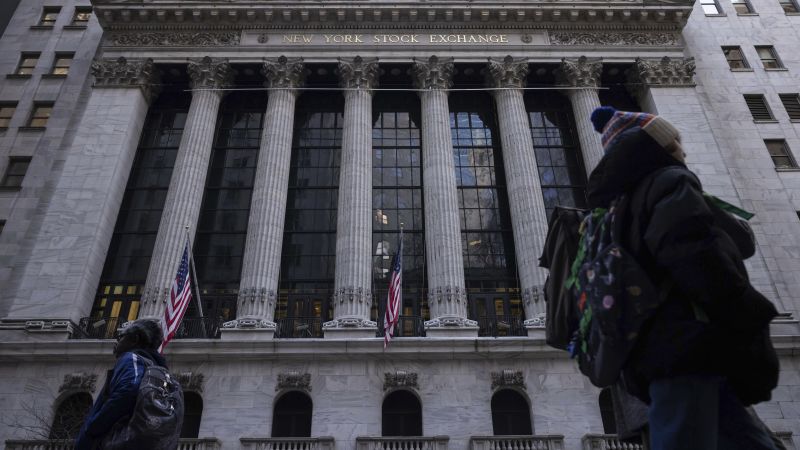A version of this story first appeared in CNN Business’ Before the Bell newsletter. Not a subscriber? You can sign up right here. You can listen to an audio version of the newsletter by clicking the same link. Before the Bell is off on Friday, March 29 and will be back on Sunday, March 31.
The first quarter of 2024 was a record-smasher for markets, even as Wall Street contended with higher-for-longer interest rates.
Investors ended 2023 on an exuberant note. Markets overcame a regional banking crisis and geopolitical turmoil and entered a powerful bull market. The economy avoided a widely expected recession. Traders eagerly anticipated the Fed would begin the first of six rate cuts this year in March.
But a spate of hot economic data and warnings from Fed officials forced investors to recalibrate those hopes to align with the Fed’s projected three cuts, likely beginning in June or July.
While the stock market saw intermittent sell-offs, it continued marching higher as robust corporate earnings and a strong labor market renewed hopes that the economy will avoid a recession. The S&P 500 index is on track to climb 10% for the first three months of the year, as of Wednesday’s close. The Dow Jones Industrial Average and the Nasdaq Composite are on pace for 5.5% and 9.3% gains, respectively.
The S&P 500 on Wednesday logged its 21st record-high close of the year. The first 17 were recorded during the first 50 trading days of 2024, the largest tally during that period since 1998, according to Bespoke Investment Research. The Dow and Nasdaq have also notched repeated record highs.
Some of the Magnificent Seven tech stocks have stumbled after spurring last year’s banner rally. Apple shares have fallen 10% this quarter on worries about lackluster sales in China. Tesla shares are on track to decline 27.6%. Alphabet shares have gained 8% so far this year but are trailing behind robust double-digit gains from Nvidia, Meta, Microsoft and Amazon.
More than just those four tech stocks have gained this quarter. The S&P 600 index, which tracks US small caps, hit a 52-week high this week after the Fed earlier this month reiterated its forecast of three rate cuts this year. The price of gold surged to multiple all-time highs. Bitcoin also reached fresh highs for the first time since 2021 after US regulators approved spot exchange-traded funds pegged to the cryptocurrency.
What’s next? Leslie Thompson, chief investment officer at Spectrum Wealth Management, says that she expects the rally to continue broadening on strong corporate earnings. Companies in the S&P 500 saw earnings grow 4.3% during the fourth quarter of 2023 from the prior year, according to FactSet data. Analysts polled by FactSet expect S&P 500 earnings to grow by more than 10% for all of 2024.
In another positive sign for markets, history suggests that new highs at the beginning of the year often portend positive annual returns. The S&P 500 has seen an average 15.8% return in years that it notched new highs in January and February, in contrast to an average 9.2% gain for all years, according to CFRA Research data going back to 1954.
But some market indicators, including Warren Buffett’s favorite, suggest stocks are overvalued compared with the performance of the economy. And investors aren’t letting their guard down, even though they’re feeling upbeat. Zachary Hill, head of portfolio management at Horizon Investments, says he’s keeping careful watch for signs of stubborn inflation in the coming months that could derail the Fed’s plans.
Still, “we don’t see a ton of major risks out there,” said Hill.
Disney and DeSantis have settled their dispute
A yearslong fight between Disney and Florida is set to end after the two parties agreed to a settlement, report my colleagues Elisabeth Buchwald and Samantha Delouya.
In a meeting Wednesday morning, members of the board of the Central Florida Tourism Oversight District, a body that governs the special tax district Disney is located in, approved a settlement to end a legal dispute.
Republican Gov. Ron DeSantis set up the Central Florida Tourism District to oversee the area in which Disney operates nearly two years ago, amid a growing conflict between the Florida governor and the entertainment giant.
The war of words between Disney and DeSantis began in March 2022, after Disney’s then-CEO Bob Chapek spoke out against the controversial bill that restricts certain instruction about sexual orientation and gender identity in the classroom. Opponents have labeled the controversial law “Don’t Say Gay.” Chapek called the bill a “challenge to basic human rights.”
Shortly after, DeSantis asked Florida’s legislature to terminate the longstanding special privileges granted to Disney in Central Florida, appointing a new board of hand-picked supervisors to oversee the district.
The board has threatened to hike taxes, raise utility rates and develop the land around the entertainment giant’s Central Florida theme parks. Disney sued DeSantis and his allies last year, claiming the company’s free speech was violated.
“Everything we’ve done has been in the best interests of the state of Florida,” DeSantis said Wednesday at a press conference in Orlando. “I’m glad that they were able to do that settlement,” he said.
Read more here.
The collapse of the the Francis Scott Key Bridge in Baltimore on Tuesday is unfortunately not the first deadly collapse of a major interstate bridge in the US, reports my colleague Alicia Wallace.
But the response to a bridge failure in Minneapolis 17 years ago, one of the most catastrophic bridge failures in recent memory, could serve as a roadmap for Baltimore moving forward.
On August 1, 2007, when cars were bumper to bumper in evening rush hour traffic along Interstate 35W in Minneapolis, the heavily trafficked, eight-lane bridge that spanned the Mississippi River suddenly failed and collapsed into the river and railyard below. Thirteen people were killed, and nearly 150 more were injured.
In addition to the tragic loss of lives and the immediate damage, the collapse of the I-35W bridge cut off a major transportation artery for the Twin Cities. About 140,000 cars a day traversed the I-35W bridge that once stood more than 100 feet above the Mighty Mississippi.
The loss of the I-35W bridge was initially estimated to sap $113,000 per day (about $17 million total in 2007 and $43 million in 2008) from the state’s economic output, according to projections from the state of Minnesota. Concern swelled about how traffic would snarl elsewhere in the state.
The enormous traffic jams did not emerge as expected, and it took only 13 months for a brand new bridge to be built.
“The economic impact was orders of magnitude less than people had feared,” Christopher Phelan, an economics professor at the University of Minnesota, told CNN.
“There was a lot of almost instant adaptability.”
Read more here.
Read the full article here




